FishDuck.com is widening its coverage of Duck sports with some UO mens basketball analysis. The goal is to break down parts of UO Coach Dana Altman’s philosophy as it pertains to the success of the basketball team. I am a retired teacher and basketball coach, and am interested in learning more about what makes Altman’s teams consistently so successful. I don’t pretend to know everything about basketball, but I love the game and I hope to utilize 34 years of successful prep coaching experience to explore some of the reasons Altman has the Ducks in the Top-25 for the first time in six years, and has Oregon competing for the Pac-12 Championship and a NCAA tournament berth.
–Coach Luke Roth
Inside-Out Play Improves Long-Range Shooting
Before the huge Arizona upset last week, Oregon was shooting an anemic 31.4% from beyond the three-point arc. That translates to 78 makes out of 248 attempts. Three point shooting certainly hasn’t been a strength of this team through the first 14 games, as there have been many long droughts from the outside — including entire halves of play where Oregon missed every attempt from three-point-land. The Ducks are hovering near the bottom of Pac-12 three-point statistical categories.
Against the 4th-ranked Wildcats, however, Oregon hit seven of 11 attempts from long-range for a sizzling 63.6%, and duplicated that  successful effort by hitting six of 11 three nights later against Arizona State. Of the ASU game, Coach Dana Altman said, “Two misses were actually thrown up at the end of the shot clock. We were actually six of nine off really good looks.”
successful effort by hitting six of 11 three nights later against Arizona State. Of the ASU game, Coach Dana Altman said, “Two misses were actually thrown up at the end of the shot clock. We were actually six of nine off really good looks.”
The difference? Improved shot selection. Against Arizona, the Ducks rarely shot the ball too quickly. Good, quick ball movement, which Altman preaches constantly, helped create open shots. Against both Arizona schools, players looked to set up teammates for opportunities by driving to the basket and then kicking the ball out to an open shooter. Senior E.J. Singler said, “All our threes came from kickouts (from inside) and from drives and kicks.”
Altman said, “I think we’re a good three-point shooting team. We’re not a great three-point shooting team. We’ve got to take the right shots and I think our guys have done a great job of that the last couple of games.”
 In many previous games, especially lopsided wins in the preseason and the loss at UTEP, players often tried to create things for themselves by going one-on-one and taking quick shots too early in possessions. Poor shots will still be taken occasionally, like the Ducks were guilty of a few times in the ASU game. The goal for Oregon is to become more consistent in all their decision-making, especially in determining when to shoot, when to drive, and when to make the extra pass.
In many previous games, especially lopsided wins in the preseason and the loss at UTEP, players often tried to create things for themselves by going one-on-one and taking quick shots too early in possessions. Poor shots will still be taken occasionally, like the Ducks were guilty of a few times in the ASU game. The goal for Oregon is to become more consistent in all their decision-making, especially in determining when to shoot, when to drive, and when to make the extra pass.
In this initial piece, I want to illustrate the following two points of emphasis in Altman’s offensive philosophy that the Ducks use to get open outside shots, and that the Ducks utilized in the wins against both Arizona schools to dramatically improve their three-point shooting:
1. Inside-Out Play. The Ducks prioritized getting the ball inside to look for high percentage shots, and when pressured defensively, the posts kicked the ball back outside. Coach Dana Altman said, “We want to go inside. That’s where our seniors are. That leads to some open looks.”
2. Penetrate and Kick. Against both the Wildcats and the Sun Devils, Oregon players attempted to drive to the hoop and kick the ball out to open teammates for wide open shots. This attacking mentality forced both Arizona and ASU into some foul trouble as each game wore on, and it provided some wide open outside shots that the Ducks knocked down.
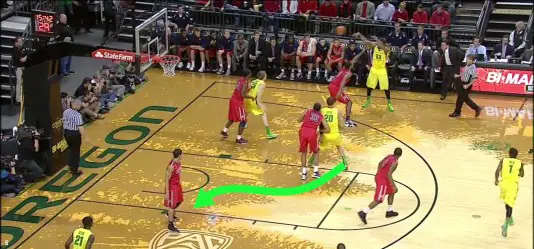 Inside-Out Sequence: (Above) An example of the Ducks going inside-out vs. Arizona man-man defense starts with Singler (25) posting up his man on the low right post and extended out a few feet. He prepares to receive an entry pass from Carlos Emory (33). Once Waverly Austin (20) at the high post sees the pass go into Singler, he needs to clear out space for Singler to operate, so he relocates to the low left post (opposite Singler…see green arrow). This clears out the middle of the key. Note Dominic Artis (1) at the top of the key area, moving to create an easy passing angle for Singler.
Inside-Out Sequence: (Above) An example of the Ducks going inside-out vs. Arizona man-man defense starts with Singler (25) posting up his man on the low right post and extended out a few feet. He prepares to receive an entry pass from Carlos Emory (33). Once Waverly Austin (20) at the high post sees the pass go into Singler, he needs to clear out space for Singler to operate, so he relocates to the low left post (opposite Singler…see green arrow). This clears out the middle of the key. Note Dominic Artis (1) at the top of the key area, moving to create an easy passing angle for Singler.
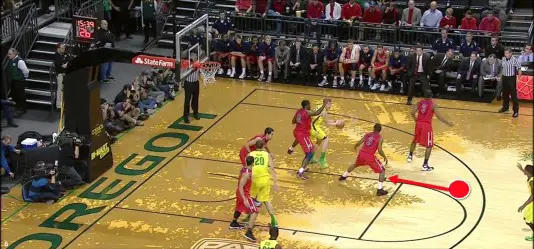 (Above) After Singler receives the entry pass, he immediately has three Arizona defenders begin to help guard him. Note Mark Lyons (2 in red) dropping down from defending Artis (1) at the top of the key to below the free throw line to help defend Singler (see red arrow). Austin (20) keeps his defender busy on the opposite post while Singler sees Artis calling for the ball.
(Above) After Singler receives the entry pass, he immediately has three Arizona defenders begin to help guard him. Note Mark Lyons (2 in red) dropping down from defending Artis (1) at the top of the key to below the free throw line to help defend Singler (see red arrow). Austin (20) keeps his defender busy on the opposite post while Singler sees Artis calling for the ball.
 (Above) Singler leaves his feet to pass (see green arrow) to a wide open Artis, who has moved into shooting position as he prepares to receive the ball. There is no way Lyon can get back to defend Artis in time to successfully defend his shot.
(Above) Singler leaves his feet to pass (see green arrow) to a wide open Artis, who has moved into shooting position as he prepares to receive the ball. There is no way Lyon can get back to defend Artis in time to successfully defend his shot.
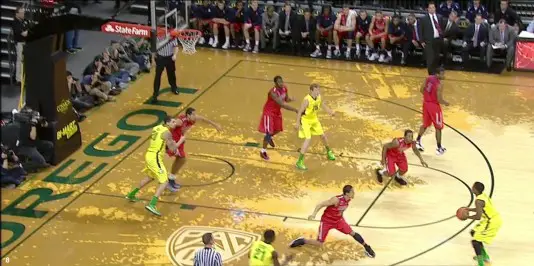 (Above) The play concludes as a wide open Artis prepares to drill a big three pointer early in the game against the Wildcats. The inside-outside concept is a simple one, yet one that works successfully over and over again when executed properly.
(Above) The play concludes as a wide open Artis prepares to drill a big three pointer early in the game against the Wildcats. The inside-outside concept is a simple one, yet one that works successfully over and over again when executed properly.
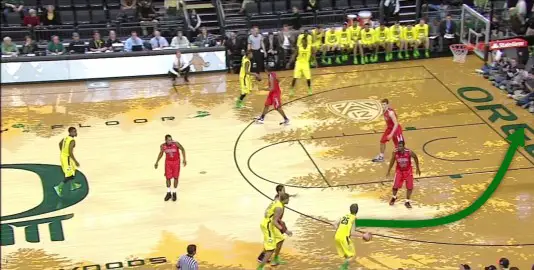 Penetrate and Kick Sequence: (Above) An example of driving and kicking after the Ducks secured possession of a loose ball. Singler (25) sees an opening from the right wing and dribble penetrates toward the hoop (green arrow).
Penetrate and Kick Sequence: (Above) An example of driving and kicking after the Ducks secured possession of a loose ball. Singler (25) sees an opening from the right wing and dribble penetrates toward the hoop (green arrow).
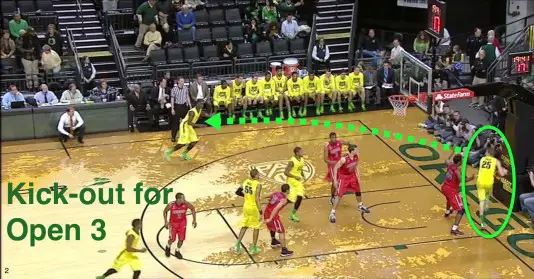 (Above) As he drives to the hoop, Singler is forced away from and below the basket by Solomon Hill (44 in red). No one picks up Damyean Dotson (21) on the left wing. Look how Dotson is moving to create a good passing angle for Singler, whose momentum is carrying him out of bounds as he begins to pass the ball (green arrow). See how close Singler’s foot was to being out of bounds before he got rid of the ball!
(Above) As he drives to the hoop, Singler is forced away from and below the basket by Solomon Hill (44 in red). No one picks up Damyean Dotson (21) on the left wing. Look how Dotson is moving to create a good passing angle for Singler, whose momentum is carrying him out of bounds as he begins to pass the ball (green arrow). See how close Singler’s foot was to being out of bounds before he got rid of the ball!
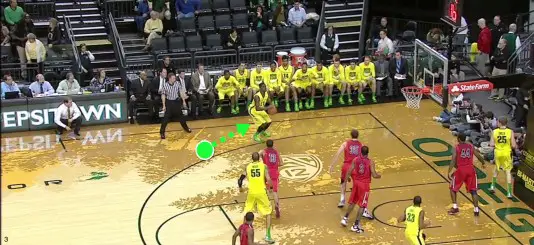 (Above) Dotson’s movement toward the best possible passing angle is the difference in whether this play succeeds or it doesn’t. He has now moved to the open spot to receive the pass, ready and balanced to shoot after Singler drew the defense away from Dotson (green arrow). That’s so often the difference in successful execution. Three or four feet of movement by Dotson at the proper time allowed this play to work.
(Above) Dotson’s movement toward the best possible passing angle is the difference in whether this play succeeds or it doesn’t. He has now moved to the open spot to receive the pass, ready and balanced to shoot after Singler drew the defense away from Dotson (green arrow). That’s so often the difference in successful execution. Three or four feet of movement by Dotson at the proper time allowed this play to work.
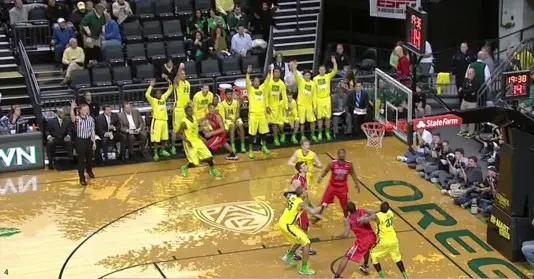 (Above) Nothing but net! Dotson buries the three pointer early in the second half against Arizona, as the Oregon bench celebrates. The penetration and kick concept is basically the same as the inside-outside game, with both having the purpose of drawing the defense to the ball in order to pass it to an open teammate away from the ball. Oregon has used both strategies recently with great success.
(Above) Nothing but net! Dotson buries the three pointer early in the second half against Arizona, as the Oregon bench celebrates. The penetration and kick concept is basically the same as the inside-outside game, with both having the purpose of drawing the defense to the ball in order to pass it to an open teammate away from the ball. Oregon has used both strategies recently with great success.
If the last two games are truly an indication of Oregon’s shooting progress, then the Ducks are showing the value of patience, ball movement, and setting up teammates for open shots. That’s a proven way to improve shooting statistics and it’s a big reason the Ducks have been so successful from long range recently. In film sessions, coaches have driven the theme of shot selection home. Singler said, “We watch ourselves and see which ones we should take and not take. It’s really helped us the last couple of games.”
Altman explained it by saying, “We’ve just been much more selective. Our guys have done a real good job of trying to go inside-out with the threes. We’re taking fewer of them because we’ve been more selective and our numbers have improved.”
It’s important to understand that by first getting the ball inside, either by passing to a post or penetrating to the hoop, and drawing the defense to the ball, that opportunities for open shots from long distance will be available at a much more frequent rate. With improved long-range shooting, the Ducks become much harder to defend. This allows other segments of Oregon’s offense to open up and become much more effective.
FishDuck.com is gradually moving to include analysis of other Oregon sports. This is the first of an ongoing series of basketball analysis, examining some of Coach Dana Altman’s philosophy as he leads the Oregon mens basketball team. I welcome comments, feedback, and suggested topics. I plan to write an article every other Wednesday through the season. As a long-time basketball coach and big-time Duck fan, I look forward to learning more about the Oregon system and to sharing some of my thoughts with you.
Related Articles:
Oregon Enters Playoffs Better Off Than Last Year
Will The Coaching Carousel Kill Oregon's CFP Chances?
The Playoff Formula Hasn't Changed
Oregon Aims to Bury Dawgs, Punch Playoff Ticket in Rivalry Clash
Huskies Are the New Beavers, Stay In Your Lane Kiffin, and the Civil Apple Cup War
Oregon Football: The X-Factor Vs. Washington
Luke Roth (Basketball Analyst) is a retired teacher and coach who has lived in Eugene since 1977. He coached high school basketball for 34 years, including 26 years as Sheldon HS girls varsity basketball coach (1984-2010). Luke taught at Sheldon for 30 years, and in the International HS at South and Sheldon, for 20 years. He taught journalism and advised the school newspaper at Sheldon during his stint there. He is a long-time Duck fan and UO alum (MA 1985). Luke has been married to his wife Catherine for 36 years with two grown children and one eight-year-old grandson. In retirement, Luke spends his time hiking, biking, gardening, writing, and playing the stand-up bass in the Sorrel Way Jam. Follow Luke on Twitter: @luke_lukeroth

